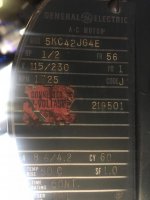I have a South Bend Lathe with what appears to be a fairly common KC series 1/2HP motor. The wiring was cut when it was moved, several years back, and now I'm trying to get it connected back up.
I've dug through some posts here, as well as googling and watching a number of youtube videos, the most useful of which was this one (see diagram at 11:58): a subscriber asked how to wire a harbor freight motor with a reversing switch - YouTube
In looking at my motor I see the following specifications:

According to the diagram in that youtube video, the connections seem to be configured for CCW rotation as we have the left hand L (equates to 1?) jumpered to connections 2 and 3, with the other L (6?) jumpered to 4 and 5.

In extrapolating a little further, his diagram would imply that we need to connect the Live or Hot to 4-5-L and that the Neutral should be connected to one of the two extraneous wires which don't go to that landing board - one of which is blue, the other of which is red.
Most of the information I have found on the web, for this series of motor, uses standard colors, so I'm hoping that these two red and blue wires are standard. I do have the reversing connection board, but don't care about connecting it up as I only want the thing to run in one direction.
Do my assumptions sound likely, or have I misconstrued something?
Am I likely to damage anything if I connect it up wrongly?
Any other helpful information would be greatly appreciated. Thanks!
I've dug through some posts here, as well as googling and watching a number of youtube videos, the most useful of which was this one (see diagram at 11:58): a subscriber asked how to wire a harbor freight motor with a reversing switch - YouTube
In looking at my motor I see the following specifications:

According to the diagram in that youtube video, the connections seem to be configured for CCW rotation as we have the left hand L (equates to 1?) jumpered to connections 2 and 3, with the other L (6?) jumpered to 4 and 5.

In extrapolating a little further, his diagram would imply that we need to connect the Live or Hot to 4-5-L and that the Neutral should be connected to one of the two extraneous wires which don't go to that landing board - one of which is blue, the other of which is red.
Most of the information I have found on the web, for this series of motor, uses standard colors, so I'm hoping that these two red and blue wires are standard. I do have the reversing connection board, but don't care about connecting it up as I only want the thing to run in one direction.
Do my assumptions sound likely, or have I misconstrued something?
Am I likely to damage anything if I connect it up wrongly?
Any other helpful information would be greatly appreciated. Thanks!
Last edited:


